
Continued from yesterday
The colonial government did not take the general strike lying down. It employed tactics of misinformation with the aid of the Nigerian Youth Movement (NYM). Dr. Akintola Maja, the NYM President, set up a “Maja Peace Committee” to convince workers to end the strike. Trade union leaders were arrested. When this failed to stop the strike, the colonial government reaffirmed its decision to sack all striking workers after August 1, 1945. A mass workers meeting was called to discuss the government’s latest threat.
The ex-Joint Executive members and their supporters who wanted to terminate the strike action were a minority. Hence, it was determined that the strike would continue despite the government’s threat of dismissal. However, the actions of the moderate trade union leaders was leading to disunity among the workers. Hence, on August 4th, the general strike was terminated in Lagos.
Workers in the provincial cities refused to believe that the strike action had been terminated by Lagos workers because of the prior misinformation by the colonial government. In Zaria, the workers refuse to go back to work until Michael Imoudu travelled down there himself to inform the workers that news of the termination of the strike action was not just another government originated propaganda designed to make them capitulate. The general strike finally ended in all parts of the country on August 15, 1945 and resulted in more than 2 million mandays lost.
In the negotiation following the general strike, the colonial government rejected the workers’ demand for 50 per cent COLAs. Instead, the government offered a 20 per cent increase in COLAs to Lagos public sector workers, smaller COLAs increases to public sector workers in the provincial cities and a minimum daily wage of 2s. 3d. for unskilled public sector workers. It told the workers’ representatives that if they rejected this offer, then it would withdraw the offer and refer the matter to a commission of enquiry. The workers’ representatives rejected the offer after consultations with trade union leaders and rank and file workers. The colonial government therefore established a commission of enquiry in October of 1945.
This commission became known as the Tudor-Davies Commission. The government did not withdraw its initial offer after the workers’ representatives rejected it. Rather, it granted the workers a 20% increase in COLAs and a minimum wage of 2s. 3d. backdated to August 1, 1945. The mandays lost during the strike were discarded as leave days without pay by the colonial government. Thus, the workers won a COLAs and wage increase after the general strike. These gains increased after the Tudor-Davies Commission finished its enquiry into the effects of the war inflation.
The terms of reference of the Tudor-Davies Commission were: “To consider the representation made by the Nigerian Government and Native Authority employees concerning an increase in the Cost of Living and, having regard to the present cost of living and all other factors, to make recommendations as to whether any action should be taken by the Nigerian Government, whether by variation of the Cost of Living Allowance or by controlling the cost of living or any other way, and to make recommendations as to the future compilation and computation of cost of living indices in Nigeria.”
In its report, the Tudor Davies commission stated that the colonial government should have kept its 1942 promise to review the cost of living. It rejected the government’s arguments of wage-push inflation and limited government revenue. It decided that the limited nature of the government revenue did not negate the validity of the workers’ claim for increased COLAs. It advised the government to change its priorities with regards to the allocation of government revenue so that it could pay the increased COLAs without raising taxes. It pointed out that the government has paid COLA to European workers. The commission recommended a 50 per cent increase in COLAs for all public sector workers (African Staff) with annual wages of less than £220 and a review of COLAs every two years. Finally, the commission concluded that “It is apparent that the influence and power of the Nigerian Trade Unions for good or ill should not be underestimated, for if their organisational strength – financial and numerical – is small, what may be termed their operational strength is great.”
The colonial government accepted the recommendations and implemented them. It also established Wage Councils to determine future wage awards and a National Negotiating Committee to settle industrial disputes in the public sector by arbitration. Rent Assessment Boards were given more powers to enforce stricter rent control measures. The government appointed a Registrar of Trade Unions to supervise the growth of the trade unions and hired a former British TUC member as a labor officer.
The 1945 general strike thus brought economic gains to the Nigerian working class. The initial 20 per cent increase in existing COLAs and a minimum daily wage of 2s. 3d. were followed by a 50 per cent increase in COLAs. The income of workers increased and this gave them the means to actualise their economic self-development at a higher level.
A national general strike is a weapon in the arsenal of Nigerian workers in struggle. It is the historical response of labour to unprovoked jabs from Nigerian government during an inflationary economy. Given the prevailing harsh economic conditions facing workers in the country, Nigerian workers should be organized to do the needful.
Concluded.
Agbon can be reached on izielenagbon@yahoo.com
Twitter:@izielenagbon












